Are you excited to welcome a new puppy into your home? Whether you’re a first-time pet owner or adding another furry friend to your family, our comprehensive checklist has everything you need to ensure your pup’s happiness and health. From food and supplies to training tips and vet visits, we’ve got you covered.
Bringing a new puppy into your home is a joyful and exciting experience, but it comes with big responsibilities. To help you prepare and make sure your new friend is comfortable and thriving, we’ve created a detailed checklist. This guide will help you navigate the initial stages of puppy ownership with ease and confidence.
Preparing for Your New Puppy’s Arrival
Bringing home a new puppy is an exciting time for any family. However, preparing for your puppy’s arrival is important to ensure they feel comfortable and safe in their new home. Here are some tips to help you prepare for bringing home a new puppy.
Puppy-proofing Your Home
One of the first things you’ll want to do is puppy-proof your home. Puppies are curious creatures and will explore every nook and cranny of your house. They’ll even stick that busy snout into spots you didn’t even know existed! This need to learn about everything means you must turn your home into a safe and secure environment for your furry one. Ensure any hazardous items, such as cleaning supplies, electrical cords, and plants, are out of their reach. Additionally, you may want to use baby gates or exercise pens to limit their access to certain areas of your home.
It’s also a good idea to get down on your hands and knees and take a look at your home from your puppy’s perspective. This will help you identify any potential hazards that you may have missed.
Setting Up a Comfortable Space
Before your puppy comes home, plan ahead by creating a designated space for your new friend to rest and relax. Ideally, this location should be a quiet and private area of your house. This space should include a comfortable bed and crate, soft blankets, and toys.
Keep their size and breed in mind when setting up your puppy’s space. If you have a larger breed puppy, you’ll want to make sure their crate and bed are big enough to accommodate their size. Additionally, you’ll want to choose a location that’s easily accessible for your puppy but also out of the way of foot traffic. Trust us when we say banging your knee on a crate corner hurts!
Choosing the Right Crate and Bedding
When it comes to choosing the best crates and bedding for your puppy, your dog’s size and breed matter. Look for a crate that’s large enough for your puppy to stand up, turn around, and lie down comfortably. Your puppy will grow fast, so think about that when selecting a crate. Do you want one that will grow with them, or will you purchase a new one when your dog outgrows their first one?
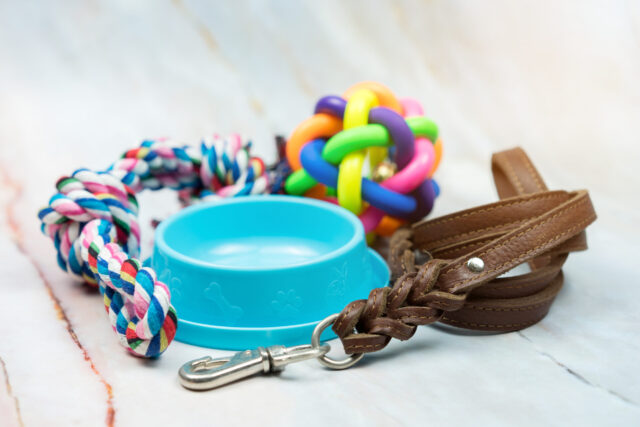
Additionally, consider the type of bedding that would be most comfortable for your puppy. Some popular options include blankets, soft foam beds, and raised beds. And don’t forget about puppy accidents. Be sure any bedding you choose can be easily washed and dried.
By following these tips, you’ll be well on your way to preparing your home for your new puppy’s arrival. Remember, with some preparation and patience, your new puppy will quickly become a beloved family member.
Essential Puppy Supplies
Now that you’ve readied your house, the next step on the new puppy checklist is choosing puppy supplies. And because the market is rich with cute puppy stuff, ensuring you have everything your pup needs before they come home is so much fun! Here are some essential dog supplies to consider for your little one:
Related: Online Puppy Classes Reviewed
Food and Water Bowls
Your new puppy will need access to clean, fresh water and food bowls. The best dog food bowls will provide a sturdy, non-tipping dining experience for your puppy and easy cleaning for you. Typically, stainless steel dog food bowls are the way to go, but some dogs may have allergies or sensitivities to certain types of food bowls, so be sure to monitor your puppy for any adverse reactions. And if you keep a busy schedule, an automatic smart dog feeder may be a great solution for feeding time.
Related: 12 Best Probiotics for Puppies
Puppy Food and Treats
Your puppy needs a well-balanced diet to grow into a healthy adult, and choosing food appropriate for their breed, size, and age is essential. Many pet stores stock a wide variety of options, and you should take the time to research and find the best puppy food for your new friend. Treats are also an essential part of training and bonding with your puppy, so be sure to pick up a few bags of soft treats or biscuits. When selecting treats for puppies, be mindful of the ingredients and avoid those that contain artificial colors, flavors, and preservatives.
Collar, Leash, and ID Tag
A collar, leash, and ID tag are vital for your puppy’s safety, as well as for identification if your pup escapes or gets lost. Invest in a high-quality collar that comfortably fits your puppy’s neck and a sturdy leash with a comfortable handle. To complete the ensemble, purchase durable dog ID tags with your phone number and address so your dog can be returned to you safely and quickly. It’s also a good idea to consider getting a microchip for your puppy, which can be implanted by your veterinarian and provides an additional layer of identification.
Grooming Supplies
Grooming is essential to your puppy’s hygiene, and you should stock up on the best grooming tools to keep them clean and fresh. Some things to consider include a brush or comb, nail clippers, ear cleaner, shampoo, and conditioner. Additionally, you may want to invest in a portable grooming table for easier grooming. Regular grooming not only keeps your puppy looking and smelling great, but it also helps to prevent skin irritations, infections, and other health issues.
Toys and Chewables
Toys are a great way to keep your puppy engaged and entertained, and it’s best to choose puppy toys made for their age and size. Look for chewable toys, rope toys, and interactive toys that promote mental stimulation and prevent boredom. Avoid toys that are small enough to be swallowed, or that can easily break apart, as these can pose a choking hazard.
Puppy Supplements
Available in various forms, including pills, powders, or chews, puppy supplements provide additional nutrients, vitamins, and minerals to fortify a puppy’s diet and help support their overall health and well-being. Multivitamins and Omega-3 fatty acids are often popular options for puppy development, but before you choose supplements for your puppy, find out what your puppy’s supplements should never contain.
Health and Wellness
Finding a Trusted Veterinarian
No new puppy checklist is complete without a veterinarian, and choosing a trusted medical professional for your dog should be one of the first and most critical decisions you’ll make. A good veterinarian will be an essential resource for your pup’s health, so it’s important to do your research and find a reputable vet in your area. When searching for a veterinarian, consider their experience, education, and the services they offer. You may want to ask for recommendations from friends or family members with furry ones. And don’t forget to check online reviews to see what other pet parents have to say about local vets.
Once you’ve narrowed down your options, scheduling a visit with each potential veterinarian can be a good idea. This will give you a chance to meet the vet, ask any questions you may have, and get a feel for their practice. You can also ask about their emergency procedures in case your puppy needs urgent care outside of regular business hours.
Vaccinations and Preventative Care
Vaccinations are an essential part of keeping your puppy healthy and preventing the spread of diseases. Your veterinarian will provide a vaccination schedule that you should follow strictly. It’s important to note that some vaccinations require multiple doses, so keep track of your puppy’s schedule and make appointments accordingly.
In addition to vaccinations, your puppy will need to be seen regularly for preventative care. This includes checkups, fecal tests, and deworming. These appointments will allow your vet to monitor your puppy’s health and catch any potential issues early on.
During these appointments, your veterinarian may also provide advice on how to keep your puppy healthy and happy. This may include recommendations on nutrition, exercise, and training. And don’t be afraid to ask questions. After all, this is your fur baby, and you want to bring them up well!
Puppy Insurance
Vet bills can get expensive, but choosing a pet insurance policy for your puppy while they’re still young can save you money in the long run. The sooner you start your puppy on pet insurance, the more likely you are to have coverage when any illnesses and chronic conditions pop up as they age. Plus, many pet insurance companies offer wellness plans that can help cover yearly vet exams and vaccinations. To find pet insurance for your puppy, enter your information in our handy pet insurance comparison tool below and have multiple quotes delivered in seconds.
Flea, Tick, and Heartworm Prevention
Fleas, ticks, and heartworms are common issues that can affect your puppy’s health and well-being. Your veterinarian will recommend preventative steps, such as using flea and tick collars or prescription medications, to minimize the risk of these issues.
It’s important to follow your veterinarian’s recommendations closely, as the best flea and tick preventative measures can help protect your puppy from serious health issues. You may also want to take additional steps to minimize your puppy’s exposure to fleas, ticks, and mosquitoes, such as keeping them away from tall grass and wooded areas. And if you do spend time outdoors, look over your dog regularly for any nasty little hitchhikers!
Spaying or Neutering Your Puppy
Unless you’re planning on breeding your puppy, it’s usually recommended to spay or neuter them. This procedure can prevent certain medical issues and behavior problems, and your veterinarian will recommend the best time to do it. Spaying or neutering your puppy is a routine procedure usually done in a single day. Your veterinarian will provide instructions on how to care for your puppy after the procedure, such as limiting their activity and monitoring their incision site.
It’s important to note that spaying or neutering your puppy can also have long-term health benefits. The Humane Society reveals the average life expectancy of spayed and neutered dogs is higher than their intact counterparts, with ‘fixed’ dogs living an average of two years longer. That breaks down to neutered males living almost fourteen percent longer than un-neutered dogs and spayed females outlasting those who aren’t by twenty-six percent. Plus, spaying your female puppy can reduce their risk of developing certain types of cancer, while neutering your male puppy can reduce their risk of developing prostate issues.
Training and Socialization
Training and socialization are also essential to your new puppy checklist, as both factors help raise a happy and well-behaved dog. Not only does training help prevent bad habits, but it also strengthens the bond between you and your furry friend. Here are some tips on ensuring successful training and socialization for your puppy.
Basic Obedience Training
Basic obedience training is the foundation of all training and should start as early as possible. Teaching your puppy simple commands such as “sit,” “stay,” and “come” not only helps with behavior but also helps with communication. Enrolling your puppy in a basic obedience training class is a great way to get professional guidance on training techniques and socialization with other puppies. And if your schedule doesn’t allow for attending training classes in person, you can conveniently train your puppy at home with online courses.
House Training and Crate Training
House training and crate training are essential for a happy and healthy puppy and a happy dog parent! Consistent routines, controlled feeding schedules, and puppy pads are just a few ways to ensure successful house training. Crate training helps with potty training and also provides a safe and comfortable space for your puppy to retreat to when needed. Remember to reinforce good behavior to create a lasting habit. Check potty-training aids off your new puppy checklist with our list of top picks.
Socializing Your Puppy with Other Dogs and People
Socialization with other dogs and people is crucial for developing a well-rounded furry friend. Puppy socialization classes, leash training, and exposure to different environments are great ways to get your puppy accustomed to the world around them. Introducing your puppy to other people and animals at an early age helps build confidence and strengthens their interaction skills. Plus, getting out and seeing the world when you’re a curious puppy is fun!
Enrolling in Puppy Training Classes
Group training classes designed for puppies are an excellent way to help your little one learn good behavior and socialization with other puppies and dogs. Professional trainers can answer questions, share insights into canine social behavior, and teach proper training techniques. Plus, it provides another excellent opportunity to bond with your puppy and learn together.
Remember, training and socialization take time, patience, and consistency. With the proper techniques and positive reinforcement, your furry friend will grow into a well-behaved and happy adult dog.
Adjusting to Life with Your New Puppy
Bringing home a new puppy can be an exciting and overwhelming experience. You’ll both need time to adjust, but there are several things you can do to ensure their overall well-being and happiness.
Establishing a Routine
Establishing a routine is essential for your puppy’s overall well-being and development. This should include consistent feeding and exercise schedules, as well as designated play and rest times. Puppies thrive on routine, and it helps them feel secure and comfortable in their new environment.
When setting up your puppy’s routine, it’s important to remember their age and breed. Younger puppies will require more frequent potty breaks and shorter play sessions, while older puppies may be able to handle longer walks and more extended playtime. Some dog breeds require more activity and stimulation than others, so be sure you’re pup has plenty to entertain them. Even if your furry one isn’t a high-energy breed, they need these things too.
Monitoring Your Puppy’s Growth and Development
As your puppy grows and develops, they’ll go through several stages, physically and behaviorally. It’s important to monitor and recognize these changes. Take pictures, monitor their growth, and record milestones. Regular checkups with your veterinarian are also crucial during your puppy’s first year of life. Your vet can help you identify any potential health issues and provide guidance on proper nutrition and exercise.
Dealing with Common Puppy Challenges
Challenges may arise as you and your puppy adjust to life together. From chewing to barking, puppies can exhibit a range of inappropriate behaviors that may require training and patience to overcome. Try to solve these issues through positive reinforcement and training techniques discussed in your training classes; however, certain behaviors may require professional intervention. Don’t hesitate to seek help when needed.
It’s also important to remember that puppies are still learning and will make mistakes. Be patient with your furry friend and avoid punishment-based training methods that can harm your relationship with them.
Building a Strong Bond with Your Puppy
Building a strong with your puppy is an essential element of puppy parenting. Reward positive behavior and spend time with your puppy, utilizing toys, tricks, and affection. The love, trust, and affection will continue to grow as your bond deepens.
Training classes can also be a great way to strengthen your bond with your puppy while teaching them important skills and behaviors. Look for classes that use positive reinforcement techniques and focus on building a solid relationship between you and your furry friend. Remember, adopting a puppy is a big responsibility, but it can also be a rewarding and joyful experience. With patience, love, and the right tools, you and your furry friend can enjoy a long and happy life together.
Additional Resources for First-Time Pet Owners
Books and Online Resources
Books, online articles, and videos provide pet parents with additional information and insight regarding puppy habits, behavior, and training techniques. These resources can be a great help when combined with professional training classes.
Local Pet Communities and Support Groups
Joining local pet communities connects you with other dog parents and provides a support system for moms and dads experiencing similar challenges. Pet clubs/discussion groups, neighborhood walks, or dog park friends are some easy ways to connect with other pet owners in your community.
Knowing When to Seek Professional Help
Professional help may be needed when it comes to your puppy’s challenging behaviors. Don’t hesitate to seek a pet behavior professional when you need further advice and guidance; their job is to help ensure your puppy’s success and happiness, after all!
Frequently Asked Questions
-
What breed of puppy is best for me?
The best breed of puppy for you depends on a variety of factors, such as your lifestyle, living situation, and personal preferences. Consider your activity level, the amount of time you can devote to exercise and grooming, and the space you have available. Research different breeds to find one that matches your needs and personality. The iHeartDogs Breed Page can also help you decide.
-
What should I feed my new puppy?
Puppies have specific nutritional needs and require a balanced diet of protein, fat, and carbohydrates. Look for high-quality puppy food that meets the standards set by the Association of American Feed Control Officials (AAFCO). You can also consult with your veterinarian for recommendations on the best food for your puppy.
-
How often should I feed my new puppy?
Puppies typically require more frequent feedings than adult dogs. Young puppies (up to 3 months old) need to be fed four times a day. From 3 to 6 months, feed them three times a day. Once they reach six months, they can be fed twice a day. These are typical guidelines; talk to your vet to learn what feeding schedule works best for your pup.
-
What vaccinations does my new puppy need?
Puppies require a series of vaccinations to protect them from common diseases. Your veterinarian can advise you on the specific vaccination schedule for your puppy, but routine vaccinations include those for distemper, parvovirus, and rabies.
-
When should I start training my new puppy?
It’s important to start training your new puppy as soon as possible. Puppies have a critical socialization period from 3 to 14 weeks of age, during which they are most receptive to learning and new experiences. Start with basic commands such as “sit,” “stay,” and “come,” and use positive reinforcement techniques. Treats are always a great motivator.
-
How should I potty train my new puppy?
Potty training your puppy takes patience and consistency. Take your puppy outside frequently, especially after meals, naps, and playtime. Use a consistent command such as “Go potty” and reward them with praise and treats when they eliminate outside. Supervise your puppy indoors and use a crate or confinement area when you can’t watch them.
-
How much exercise does my new puppy need?
The amount of exercise your puppy needs depends on their breed, age, and activity level. Puppies generally need at least 30 minutes of exercise daily, but this can vary. Consult with your veterinarian for recommendations on exercise and playtime for your puppy.
-
How can I keep my new puppy safe and healthy?
To keep your puppy safe and healthy, provide proper nutrition, regular exercise, and preventative veterinary care. Keep toxic substances and dangerous objects out of their reach, supervise them closely, and provide them with a safe and comfortable living environment.
-
How do I introduce my new puppy to other pets in the house?
Introducing your new puppy to other pets in the house should be done gradually and carefully. Allow them to sniff each other through a barrier, such as a gate or door, and supervise their interactions closely. To prevent territorial issues, provide separate food and water bowls, beds, and toys. Try out these six tips to make introductions a little easier.
-
How do I establish a routine for my new puppy?
Establishing a routine for your new puppy is vital for their development and behavior. Set consistent times for feeding, exercise, playtime, and rest. Use positive reinforcement techniques to reward good behavior and be patient as your puppy learns and adjusts to their new routine.
Final Thoughts
As a first-time dog owner, owning a puppy can be a rewarding responsibility. Going into this exciting adventure knowing the essentials and what it entails makes the experience satisfying and enjoyable for everyone involved. Proper training, continued care, and lots of love make raising a puppy wonderfully fulfilling and create a lifelong partnership. At the end of the day, always remember to approach puppy ownership with care, patience, and affection.
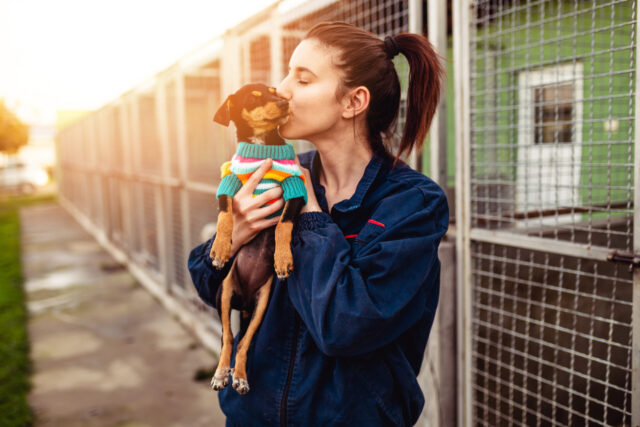
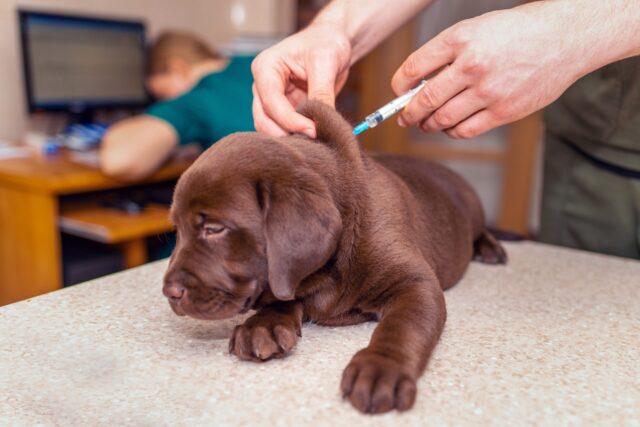
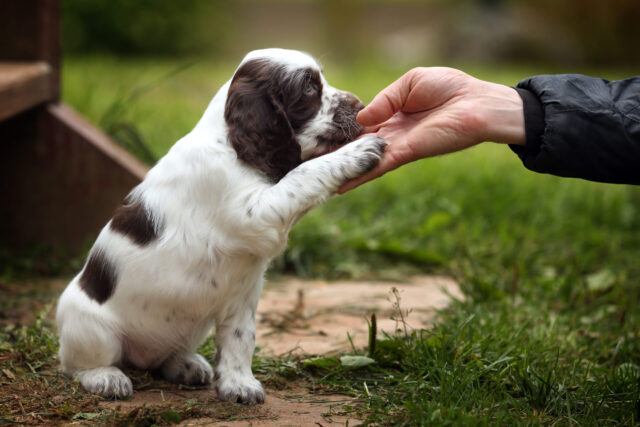

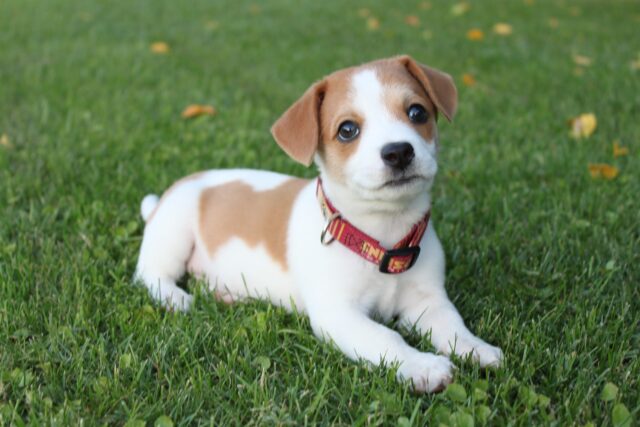
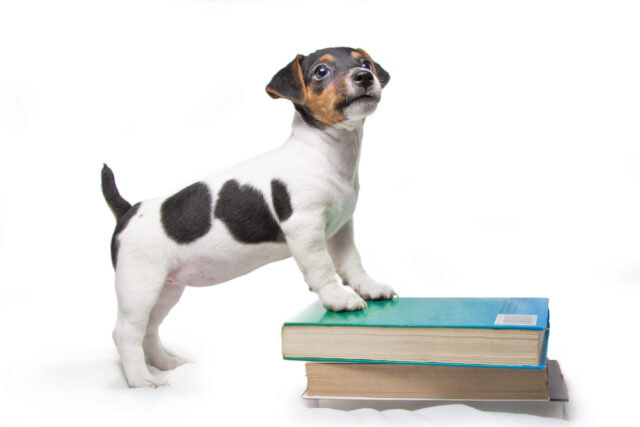
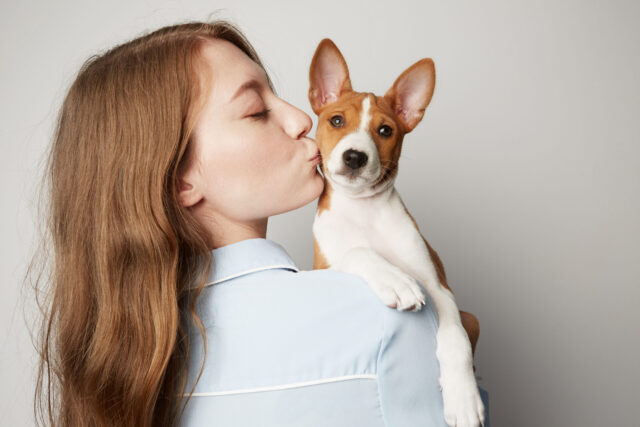
 Toledo, United States.
Toledo, United States.